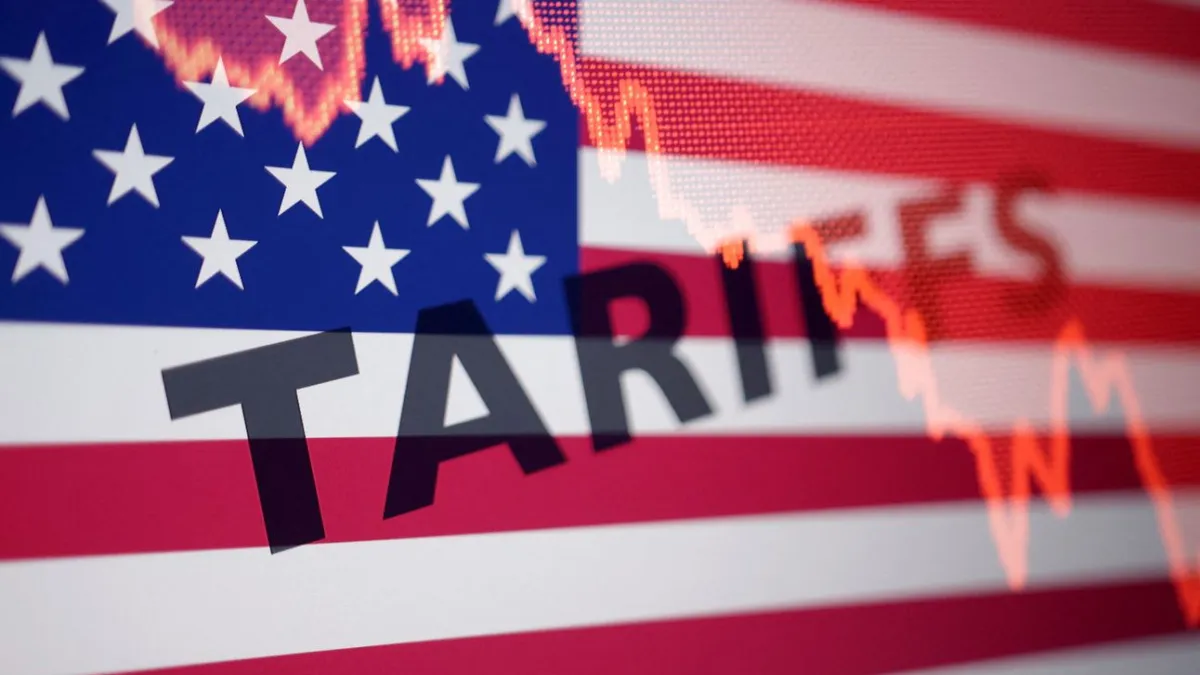
Rattled by a rapid-fire series of changes in government policy under the new Trump administration, including the threat of sharply higher tariffs and major layoffs at federal agencies, the U.S. economy contracted at an annual rate of 0.3% in the first quarter of 2025, the Commerce Department announced Wednesday.
It was the first quarterly shrinking of the economy since the first three months of 2022, when the world was struggling with the Covid pandemic, and it marked a major downshift from the 2.4% annual growth rate over the final months of 2024.
The primary driver of the contraction was a big jump in imports, which are subtracted from GDP, along with a decline in government spending. Imports surged as U.S. firms scrambled to stock up on finished goods and raw materials from overseas before President Donald Trump’s tariff increases on trading partners around the world took effect in April.
The jump in imports subtracted nearly 5 percentage points from the topline GDP number, which registered the largest reduction from net imports since at least 1947, The Wall Street Journal reported.
In a separate report released Wednesday morning, the personal consumption expenditures price index rose 2.3% in March on an annual basis, above the consensus estimate of 2.1%. The core PCE index, which ignores volatile food and fuel prices to provide a better sense of the underlying trend, also came in a bit hotter than expected at 2.6%. Economists had expected to see 2.5%. On a monthly basis, though, core PCE was basically flat.
White House pushes back: Speaking at a Cabinet meeting, Trump distanced himself from the news, blaming his predecessor for the negative results. “You probably saw some numbers today, and I have to start off by saying that’s Biden — that’s not Trump — because we came in in January,” Trump said. “We came in and I was very against everything that Biden was doing in terms of the economy. … We took over his mess in so many different ways.”
Soon after the report was released, Trump said on social media that the markets, which tumbled before recovering later in the afternoon, are still under the sway of “the Biden ‘Overhang’” and that any decline in stocks has nothing to do with his policies, including tariffs. Stocks this year saw their worst start to a presidential term since 1974.
“This is Biden’s Stock Market, not Trump’s.” (Critics noted that Trump had claimed exactly the opposite before he won reelection, when he took credit for a rising market under President Joe Biden. “THIS IS THE TRUMP STOCK MARKET BECAUSE MY POLLS AGAINST BIDEN ARE SO GOOD THAT INVESTORS ARE PROJECTING THAT I WILL WIN, AND THAT WILL DRIVE THE MARKET UP,” Trump wrote in January 2024.)
White House trade advisor Peter Navarro went a step further, saying the GDP report contains all kinds of good news. “I got to say just one thing about today’s news, that’s the best negative print I have ever seen in my life,” he told CNBC.
Navarro cited an increase in domestic investment as a sign that the economy is actually doing well, once you ignore the effects of Trump’s policies. The increase in investment “is off the charts when you strip out inventories and the negative effects of the surge in imports because of the tariffs, you had 3% growth,” Navarro said. “So, we really like where we’re at now.”
Democrats weren’t buying the spin, though, and had a field day with the negative topline number. “Donald Trump inherited a strong economy — and in just 100 days, he’s driving it straight into a ditch,” said Democrats on the House Budget Committee. “This is what happens when you let a chaos agent run the economy. Trump’s boneheaded trade war is rattling markets and gutting middle-class families in real time.”
Stagflation fears rising: Although the White House was no doubt spinning the report fairly hard, economists agreed that the underlying data is not as bad as the topline number. “The headline decline overstates weakness because a lot of that was tariff-induced pull-forward,” said Shannon Grein, an economist at Wells Fargo, per the Journal. “Overall, I think that it was a relatively solid underlying report when it comes to demand.”
Still, the economic outlook is not as rosy as the Trump administration may like you to believe. Mark Zandi, chief economist at Moody’s, told the Journal that the GDP report “probably overstates the economy’s weakness, but the economy’s weak” nevertheless. Consumer spending is slowing and Americans are growing increasingly worried about higher inflation and potential job losses — the stagflationary combo that dogged the economy in the 1970s.
RSM Chief Economist Joseph Brusuelas said the report indicates that the economy “rests on the knife’s edge.” The economy is slowing, Brusuelas warned, and the headwinds are only growing stronger thanks to Trump’s trade war. “While the economy did not tumble into a recession in the first quarter, unless there is a quick unwinding of the tariffs now hitting the economy, a recession will take place in midyear,” Brusuelas wrote in a research note Wednesday.
A record trade deficit: Economist Diane Swonk of KPMG noted that the trade deficit was a historic $322 billion in the first quarter — a “stunning” figure that nearly doubles the previous record set in 2020 as the economy reopened during the pandemic and U.S. consumers rushed to purchase all kinds of products. The trade deficit will likely shrink in the second quarter, but that will reflect weakness and not strength as consumers and firms struggle with rising tariffs, Swonk said, adding that the resulting price hikes could put the Federal Reserve in a difficult spot.
"Unlike the pandemic-induced inflation, we do not have a cushion on savings to buoy spending today," Swonk wrote. "Sadly, the Federal Reserve will be handcuffed by the tariff-induced inflation and unable to offset the blow to demand until that abates."